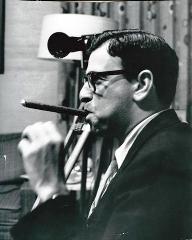
The Bulletin – Dec 18, 1983
About this time each year readers expect me to name the best played bridge hand of the year: one in which the play is difficult and the player is a genuine hero or heroine — not just some lucky stiff who stumbled into the winning maneuver.
Today’s hand, my nomination for the best hand of the year, was played in the first Epson International Bridge Tournament, held last June in Tokyo before a large audience of bridge enthusiasts. You must decide the difficulty of the play for yourself, but I’m sure you’ll agree that virtue triumphed when it is revealed that the successful player was Toronto expert Sami Kehela. Bridge players consider hints one of the great technicians of the game.
When today’s hand was played between Kehela’s Canadian team and a team from London, the declarer in the first room took the first trick with the queen of clubs and led a diamond in the hope of getting his ninth trick before the defender knew what was going on.
If the clubs were divided 4-4, the defenders could take only three clubs and the ace of diamonds. But there might be chances even if the club break was less favorable. If West had the ace of diamonds he might automatically play low with the king-jack in dummy, in the hope that South was missing the, queen of diamonds also and would misguess.
South’s play was doubtful since the odds were more than 2 to 1 against’s 4-4 break! in clubs. The defenders had no problem. East took the ace of diamonds and returned a club, whereupon West defeated the contract before South know what was going on.
When the hand arrived at Kehela’s table, he took the queen of clubs and his five spade tricks. If the clubs were divided 4-4 to begin with, they would still be divided favorably after South had run the spades. Kehela would have no discarding problems, but perhaps one of the opponents would. In any case. Kehela thought he might find something out by taking the spades and that all of his options would still be open.
Kehela discarded a heart and then two diamonds on the spades. East followed suit four times and then discarded the eight of diamonds. West discarded two low diamonds thoughtfully and then the 10 of diamonds without any great joy.
Kehela thought West’s unwillingness to discard a heart was significant. Kehela also read the meaning of the eight of diamonds and came to the conclusion that West had parted with all of his diamonds. If it had been right to lead a diamond to begin with, Kehela could lead a diamond now; but he really knew what was going on and had the courage to back his judgment.
After taking a club and five spades, Kehela led a club. West could cash his four clubs, but then had to lead a heart.
Kehela had kept three hearts in each hand and was therefore sure to win the last three tricks, making his contract.
«Well played» sayed West.
And so, I trust, say all of us.
ACBL Hall of Fame Sami Kehela
